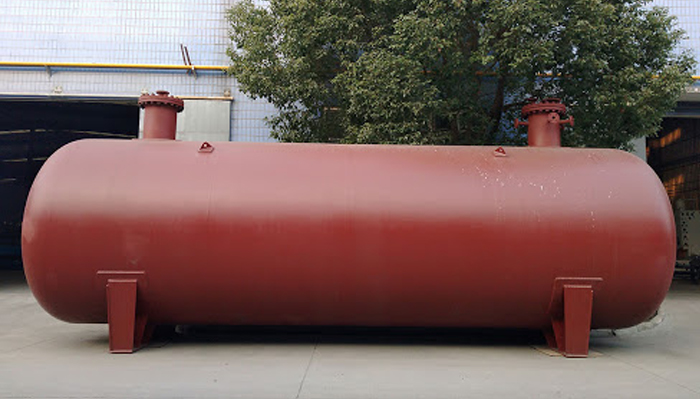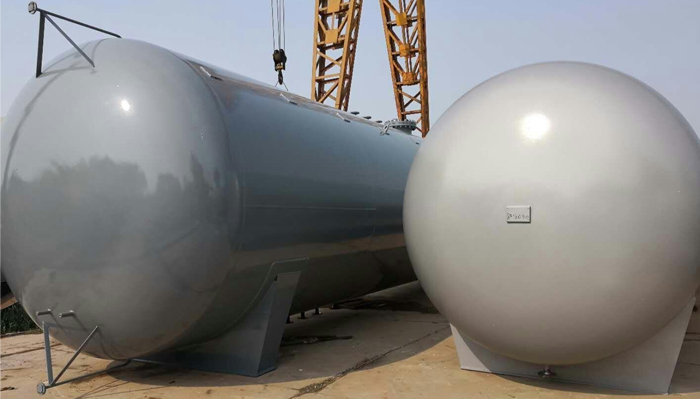Product Category
LPG ground tank and underground tank are more economical in terms of land use, cost and safety?
Date: Feb 05, 2020

Who has the advantage of the above-ground tank of LPG (liquefied gas) storage tanks compared with underground tanks? Let us compare the three aspects of land use, cost and safety.
1. Land
Nowadays, the land price has been rising all the way, which can be described as the size of the land. According to the provisions of the "City Gas Design Code": the single storage tank volume does not exceed 50 cubic meters, and the total capacity does not exceed 400 cubic meters. It can be reduced by half compared to the ground tank, and many other safety clearances can be reduced. Therefore, if your total capacity is less than 400 cubic meters, selecting an LPG underground tank can save land area. For example, if you also build two 50 cubic meters, one 20 cubic meters, and a total capacity of 120 cubic meters, if it is Above-ground tanks require about 3,300 square meters of land, but for LPG underground tanks, only 2,000 square meters of land are required. 2.Cost
2.Cost
LPG underground tanks have more DN450 manholes in the structural design than above-ground tanks, so the price of a simple storage tank will also be more expensive than that of LPG above-ground tanks. In addition, the LPG underground tanks are buried underground, in order to avoid The soil corrodes the surface of the tank. Each storage tank must be treated with anticorrosion, and the foundation of the storage tank must be underground about 4 meters from the ground. The cost of civil construction will be much higher than that of the tank above the ground. The surface of the buried tank should be filled with sand at least 400 mm thick. The installation operation is also more complicated than the above-ground tank, the workload is large, and the installation cost will increase. Therefore, if your land is relatively spacious, the amount of ground tanks will be much smaller.
3. Safety
Because the current design and installation of LPG stations have been reviewed and supervised by special inspection institutes, fire protection, environmental protection, meteorology, technical supervision bureaus and other departments, illegal construction projects will not pass. After the entire pipeline is installed, airtight tests and non-destructive testing are also performed. Other monitoring equipment such as liquefied gas concentration alarms and emergency shutdown systems must also be installed in the gas station. Therefore, as long as the user works and operates according to regulations, there is no big difference in safety, and both are relatively safe.
1. Land
Nowadays, the land price has been rising all the way, which can be described as the size of the land. According to the provisions of the "City Gas Design Code": the single storage tank volume does not exceed 50 cubic meters, and the total capacity does not exceed 400 cubic meters. It can be reduced by half compared to the ground tank, and many other safety clearances can be reduced. Therefore, if your total capacity is less than 400 cubic meters, selecting an LPG underground tank can save land area. For example, if you also build two 50 cubic meters, one 20 cubic meters, and a total capacity of 120 cubic meters, if it is Above-ground tanks require about 3,300 square meters of land, but for LPG underground tanks, only 2,000 square meters of land are required.

LPG underground tanks have more DN450 manholes in the structural design than above-ground tanks, so the price of a simple storage tank will also be more expensive than that of LPG above-ground tanks. In addition, the LPG underground tanks are buried underground, in order to avoid The soil corrodes the surface of the tank. Each storage tank must be treated with anticorrosion, and the foundation of the storage tank must be underground about 4 meters from the ground. The cost of civil construction will be much higher than that of the tank above the ground. The surface of the buried tank should be filled with sand at least 400 mm thick. The installation operation is also more complicated than the above-ground tank, the workload is large, and the installation cost will increase. Therefore, if your land is relatively spacious, the amount of ground tanks will be much smaller.
3. Safety
Because the current design and installation of LPG stations have been reviewed and supervised by special inspection institutes, fire protection, environmental protection, meteorology, technical supervision bureaus and other departments, illegal construction projects will not pass. After the entire pipeline is installed, airtight tests and non-destructive testing are also performed. Other monitoring equipment such as liquefied gas concentration alarms and emergency shutdown systems must also be installed in the gas station. Therefore, as long as the user works and operates according to regulations, there is no big difference in safety, and both are relatively safe.
Next article:
Send Your Inquiry
We not only provide a good product, but also provide high quality service. If you are interested in our products,
you can contact us in the following ways.
you can contact us in the following ways.







